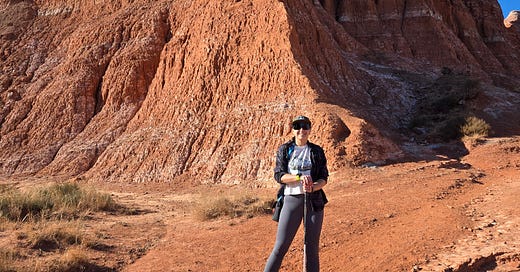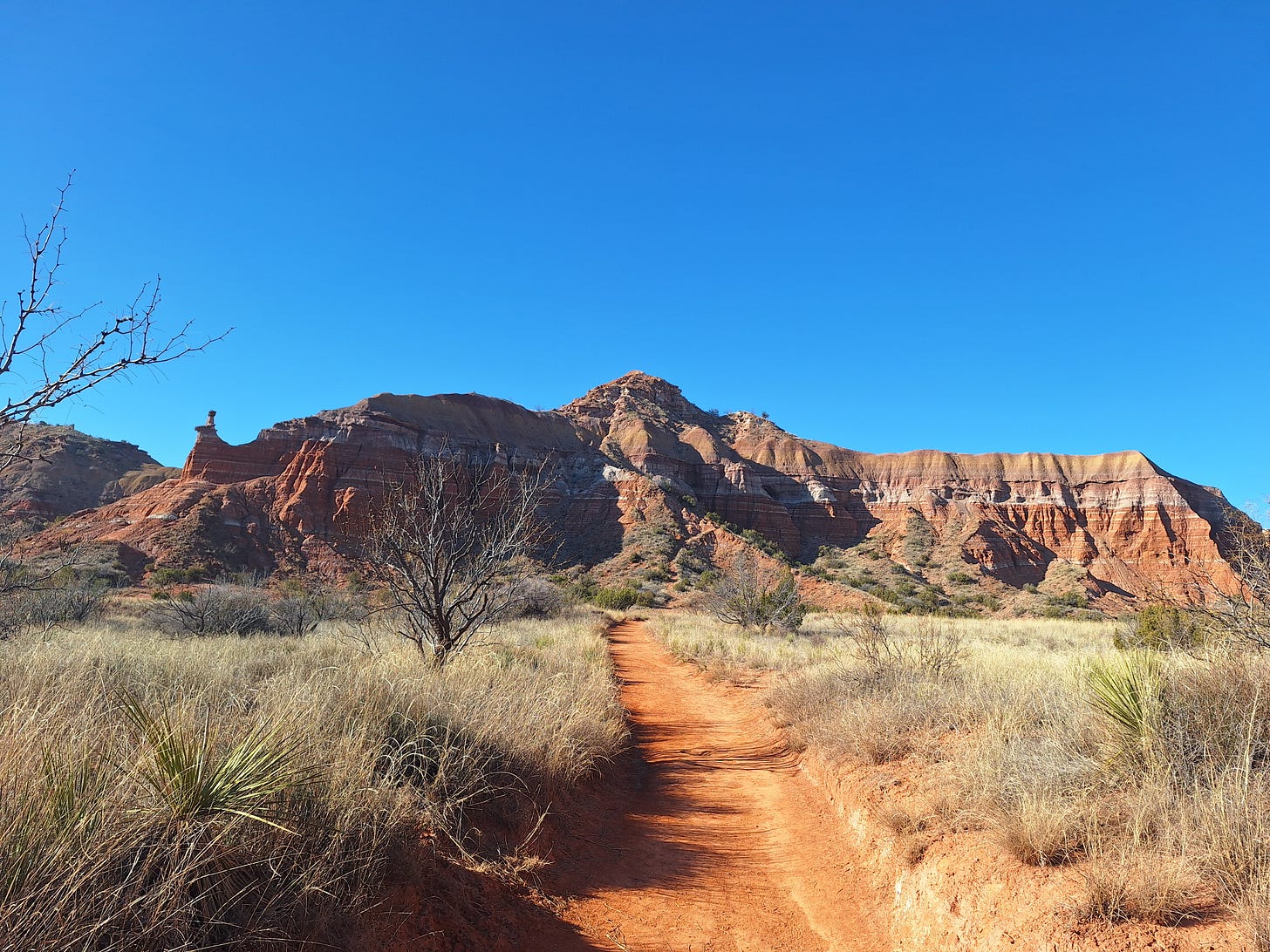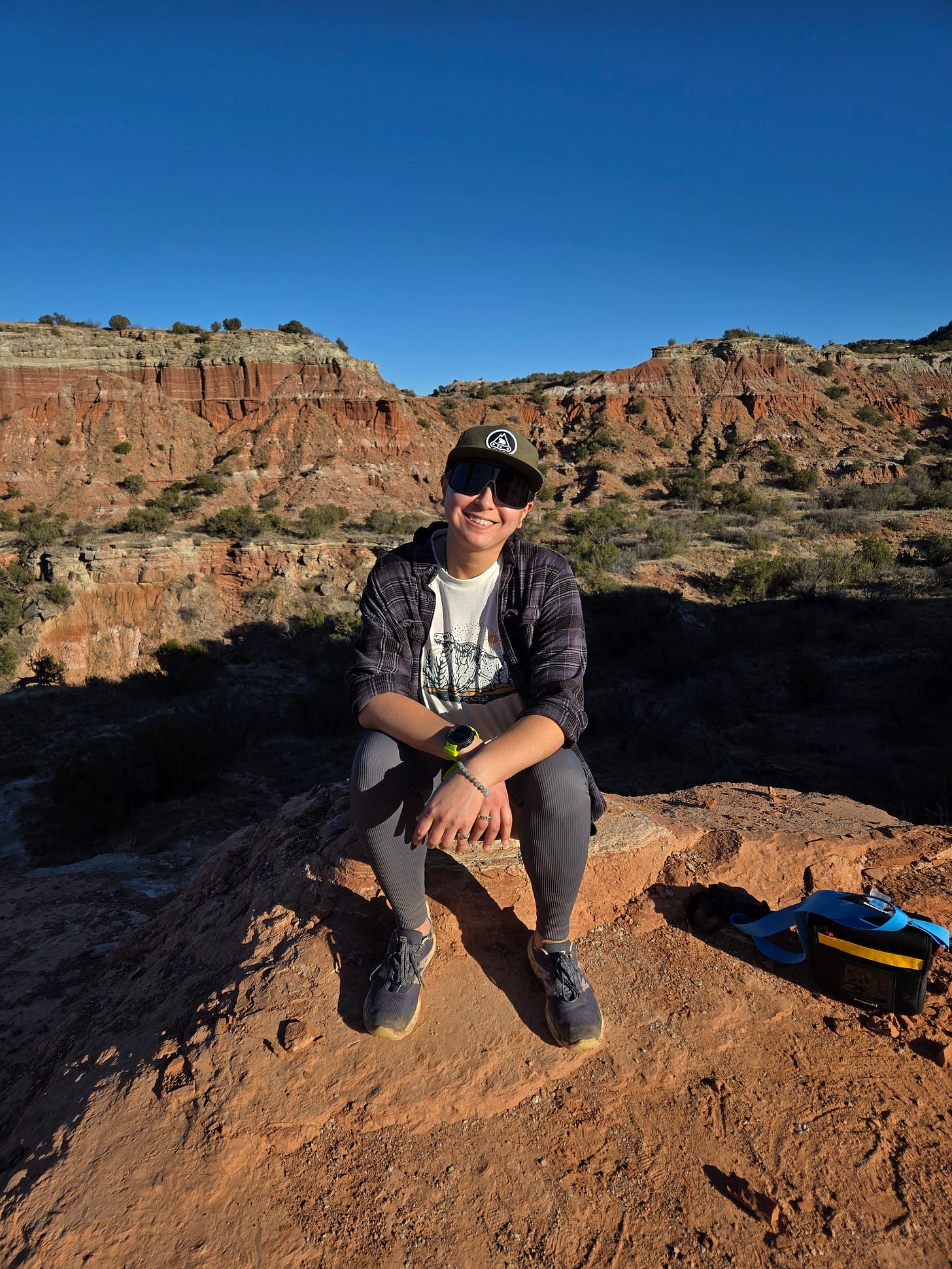People like to remind me of how flat my home state is. No, it doesn’t have the harsh and jagged Rocky Mountains of the current state I reside in or the green and ancient Appalachians of the east, but the diverse landscapes of Texas continue to surprise me.
Palo Duro is one of the largest canyons in the United States and is located in the unassuming Texas panhandle with the state park just 30 minutes southeast of Amarillo. Four years ago, my dad and I started our mini road trip from Fort Worth, Texas. A cool 5 hour drive from my parents home and trust me, “Amarillo By Morning” by George Strait was played many times in the old Chevy pickup.
We took this trip during the month of August when Texas is arguably its hottest because both my father and I’s spontaneity knows no bounds. Really, I was out of work with severe cabin fever and my dad’s summer vacation was coming to an end, so the stars aligned during the height of Covid.
Fast forward to December 2024, my partner and I are rushing down panhandle roads to make our late in the day adventure. We were just in Denver that morning where we began our yearly trek back to Texas for the holidays. The 7.5 hour drive breezed by since we decided to break up the usual 12.5 hour trip into two days so we could explore a couple state parks along the way. As we exited the major highway and turned left the canyon snuck up on us as the road blends into the state park entrance. On the shortest day of the year, we only had the afternoon to explore Palo Duro Canyon State Park so we had to make sure we did the iconic Lighthouse Trail. As the symbol of the park, the Lighthouse is one of the most recognizable rock features of all the Texas state parks. A breezy 3 mile hike to the picturesque formation, we walked passed millions of years of geological history.
One million years ago, The Prairie Dog Town Fork of the Red River, a now timid braided river system was dynamic and carried large swaths of sediment as it cut through layers of ancient sedimentary rock. Even now, if you are lucky - or not so lucky to witness the intense storms that hit the Texas panhandle, flash flooding swells the rivers with forces that continue to shape the canyon today. Rivers are not the only force that shapes the canyon we see today. The composition of the rocks themselves lead to differential weathering as softer rocks erode faster leaving behind more resilient layers. This creates the unique hoodoo like features seen throughout the park, including the famous Lighthouse.
The distinct, stratified colors of the canyon walls tell a story of Texas past. The oldest formation exposed, the Quartermaster, shows evidence of shallow marine environments of Permian age seas from over 245 million years ago. These red rocks are glittered by gypsum, an evaporative mineral from drying flats along the edge of these long missing seas. Ripple marks and cross bedding are further clues into this past environment. Above the Quartermaster formation is a myriad of colors, pinks, greens, tans, whites, yellows, and browns making up the lower mudstones of the Tecovas formation and the ledgy durable sandstones of the Trujillo formation. From the Triassic period, these formations and usually packaged together as the Dockum group. The Tecovas was formed by streams and swamps evidenced by plant, early reptile, and amphibian fossils found. Easily spotted sandstone ledges are made up of the Trujillo formation. The course sands and cross bedding indicate stream systems where the rare fossil appears, with the cap of the Lighthouse made up by the Trujillo. The Ogallala formation tops the cliffs of Palo Duro Canyon. Consisting of tan sandstones, conglomerates, and siltstones, these layers formed 4-10 million years ago with a caliche cap topping the formation and canyon, indicating a time of drying and environmental change. As the Rocky Mountains rose, the sediment left behind formed the Ogallala. Nearly 200 million years of geologic layers are missing between the Trujillo and Ogallala creating an unconformity leaving out much of the Mesozoic, so no dinosaur fossils are present in the canyon. The age of mammals is showcased in this formation as remains of dogs, mastodons, rhinos, horses, camels and saber-toothed cats, have been uncovered in its layers.
As the sun began to set, we made our way back to the trailhead. I was washed with a sense of comfort as it had been months since we had a moment enjoy a hike together. In between the occasional pause to greet and share exchanges with fellow hikers, our conversations blossom from silly to serious to silly all over again. Surrounded by clues of my home state’s geologic past, I share my excited nervousness to be back. Still hours away from where I grew up, nostalgia and memories well up as I think of all the things I miss about home. Texas has changed a lot since I was a child and even some as I have moved away. There are things I don’t even recognize anymore and I don’t think I would ever move back but as soon as I reach those state lines I feel like I belong. Some of my favorite places and most embarrassing moments lie within the state parks, Whataburgers, and bars of the Lone Star State. Palo Duro is one of these places, where I can revel in my geologic passions and complicated love for the state that shaped me.
Till next time, keep rocking!
References:
Matthews, W., 1969, The Geologic Story of Palo Duro Canyon, Project Gutenberg, https://www.gutenberg.org/files/52179/52179-h/52179-h.htm#c8.
Spearing, D., 1991, Roadside geology of Texas (2nd ed.): Missoula, Montana, Mountain Press Publishing Company, 379-386 p.









